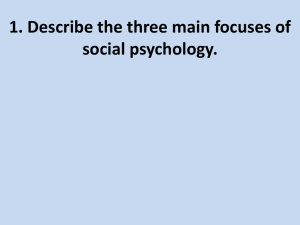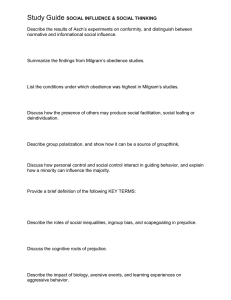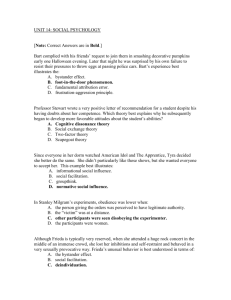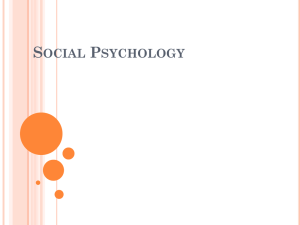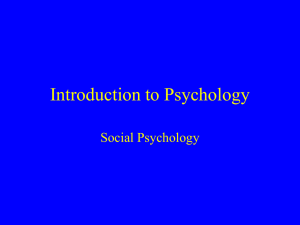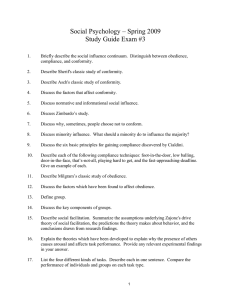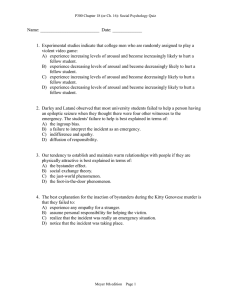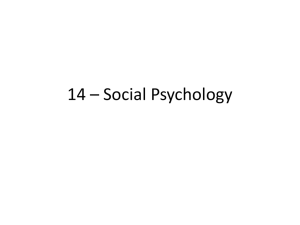CH 15 Short Practice Test.doc
advertisement
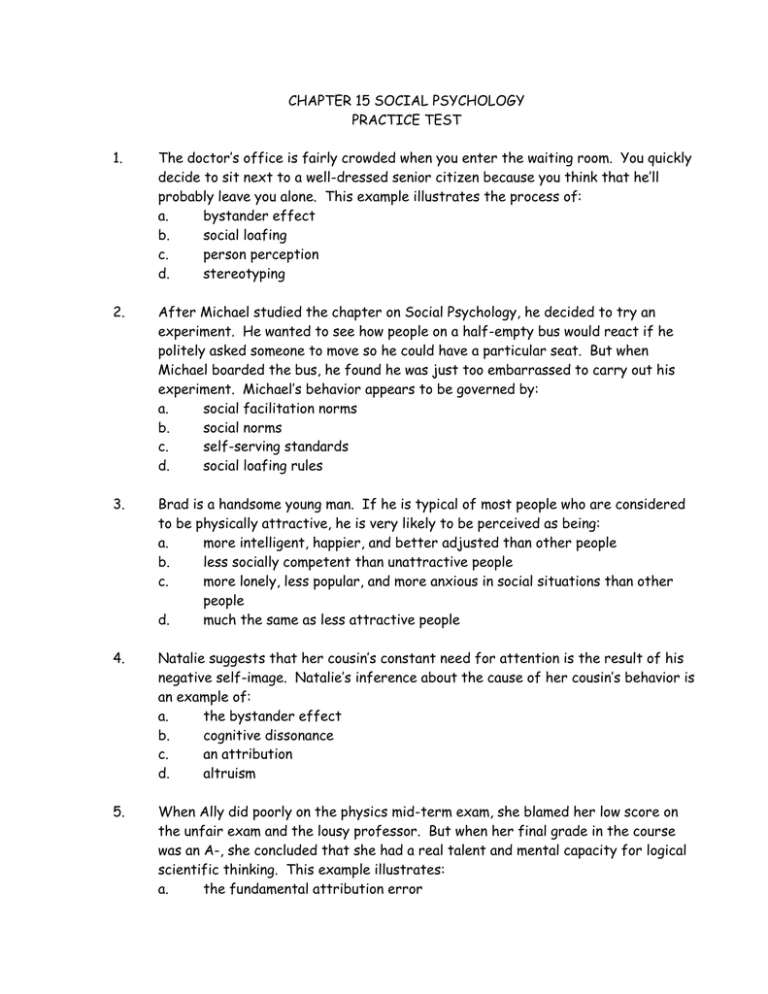
CHAPTER 15 SOCIAL PSYCHOLOGY PRACTICE TEST 1. The doctor’s office is fairly crowded when you enter the waiting room. You quickly decide to sit next to a well-dressed senior citizen because you think that he’ll probably leave you alone. This example illustrates the process of: a. bystander effect b. social loafing c. person perception d. stereotyping 2. After Michael studied the chapter on Social Psychology, he decided to try an experiment. He wanted to see how people on a half-empty bus would react if he politely asked someone to move so he could have a particular seat. But when Michael boarded the bus, he found he was just too embarrassed to carry out his experiment. Michael’s behavior appears to be governed by: a. social facilitation norms b. social norms c. self-serving standards d. social loafing rules 3. Brad is a handsome young man. If he is typical of most people who are considered to be physically attractive, he is very likely to be perceived as being: a. more intelligent, happier, and better adjusted than other people b. less socially competent than unattractive people c. more lonely, less popular, and more anxious in social situations than other people d. much the same as less attractive people 4. Natalie suggests that her cousin’s constant need for attention is the result of his negative self-image. Natalie’s inference about the cause of her cousin’s behavior is an example of: a. the bystander effect b. cognitive dissonance c. an attribution d. altruism 5. When Ally did poorly on the physics mid-term exam, she blamed her low score on the unfair exam and the lousy professor. But when her final grade in the course was an A-, she concluded that she had a real talent and mental capacity for logical scientific thinking. This example illustrates: a. the fundamental attribution error b. c. d. actor-observer discrepancy blaming the victim the self-serving bias 6. A(n) is a learned tendency to evaluate some object, person, or issue in a particular way that may be either positive, negative, or ambivalent. a. stereotype b. self-effacing c. attitude d. prosocial behavior 7. Mrs. Thompson thinks that all teenagers are reckless, promiscuous, irresponsible delinquents. Mrs. Thompson appears to be associating qualities that are unrelated to the objective criteria that define this particular age group. This example illustrates: a. stereotyped thinking b. discrimination c. prosocial thinking d. cognitive dissonance 8. During Nigel’s first trip abroad, he was surprised to find that people in other cultures ate such food as snails, squid, lizards, earthworms, seaweed, and rottenlooking cheeses. “One day they will become civilized like us and eat normal food like donuts, pizza, hot dogs, and French fries,” he wrote to his parents. Nigel’s remarks illustrate: a. actor-observer discrepancy b. ethnocentrism c. deindividuation d. stereotyping 9. Kelly attended a concert with several of her closest friends. At the end of the concert, Kelly’s friends jumped to their feet and applauded. Although Kelly was not impressed with the bank or concert at all, she too jumped to her feet and applauded. This example illustrates: a. deindividuation b. obedience c. conformity d. social loafing 10. The performance of an action in response to the direct orders of an authority or person of higher status is a definition of: a. conformity b. c. d. obedience deindividuation social facilitation 11. In Milgram’s obedience study, subjects who were assigned the role of “teacher”: a. were temporarily deceived about the real role of the learner and the actual amount of shock b. were told to leave whenever they felt the slightest discomfort c. seemed to enjoy shocking the learner, especially at the higher voltage levels d. quickly figured out the learner was not really getting shocked 12. If Jerome takes part in a replication of Milgram’s obedience experiments that involves observing two other “teachers” refusing to continue, it is very likely that he: a. will also refuse to continue to administer shock at the highest level b. will give more shocks at the highest level to compensate for the two teachers who quit c. will demand to be paid more money for continuing with the experiment d. will enjoy shocking the learner more than other subjects who did not observe people refusing to obey 13. Tom Davis has selflessly spent the majority of his adult life helping the homeless receive shelter, clothing, and food. This example illustrates: a. altruism b. ethnocentrism c. attribution d. social facilitation 14. Which of the following is NOT one of the factors that increases the likelihood of bystanders helping? a. feeling good, successful, happy, and fortunate b. feeling guilty for not helping c. seeing others who are willing to help d. perceiving those in need as undeserving of your help 15. While studying in the crowded library, Sydney hears a crashing noise and then someone moaning. The commotion appeared to come from behind closed doors marked “Staff Only.” Nobody near Sydney seemed concerning, so Sydney goes back to her studying. This example illustrates: a. the bystander effect b. social facilitation c. d. altruism deindividuation 16. Peggy worked very hard as a volunteer research assistant on Dr. Milton’s research project because she wanted to get her name on the publication. Peggy’s helping behavior best illustrates: a. altruism b. social facilitation c. prosocial behavior d. obedience 17. Your reactions to other people are determined by that person’s true characteristics. a. True b. False 18. The in-group bias refers to the tendency to see members of out-groups as being very similar to one another. a. True b. False 19. Prejudice is displayed emotionally, whereas discrimination is displayed behaviorally. a. True b. False 20. The greater the number of people present, the more likely each person is to help someone in need. a. True b. False CHAPTER 12 PRACTICE TEST ANSWERS 1. 2. 3. 4. 5. 6. 7. 8. 9. 10. 11. 12. 13. 14. 15. 16. 17. 18. 19. 20. C B A C D C A B C B A A A D A C B B A B
